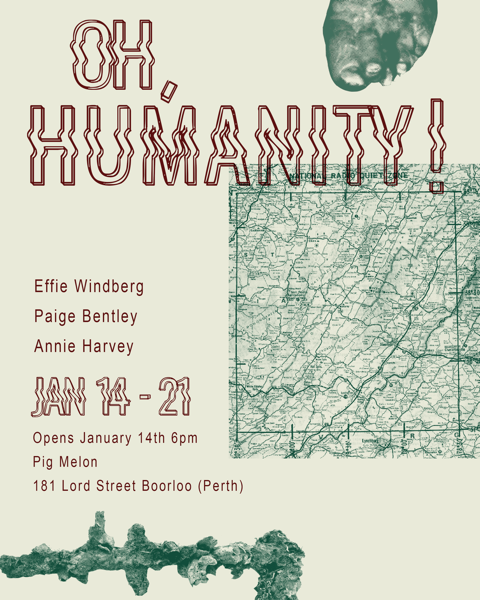Effie Windberg
Paige Bentley
Annie Harvey
Opens 14 Jan 2022
Exhibition continues 15 Jan – 21 Jan 2022
Oh Humanity – Effie Windberg | Paige Bentley | Annie Harvey

Effie Windberg’s work occupies Pig Melon under the guise of The Department of Environmental Archives - a fictional unofficial organization aiming to document local environments and observe the impact of human life in these sites. Members adopt the role of the dilettante, claiming to have no expert knowledge over their field of investigation, thus making novel interpretations of sites and environments.
The works in this show are created from the point of view of an anonymous Department Worker, and document their fieldwork research of magnet fishing underneath the Old Fremantle Traffic Bridge where the depths house an archive of lost objects. Tools and findings from fieldwork are presented using both museological methods of display and ad-hoc installation, interpreting found objects through the lenses of both preservation and functionality.
Accepted into the habitat of the ocean, castaway objects quickly become colonized by tiny lace-like corals, and flourish as artificial reefs. These encrustations slow the corrosion, but render them difficult to recognize as familiar objects. With the task of identification and interpretation shared by researcher and audience alike, the role of the object becomes speculative - suggesting imagined and fabricated histories of place. Investigating ideas of place, informal history, and perceptions of value, Effie Windberg explores the subjective memories of objects presented through the lense of the archival collector. Often appropriating processes employed in the fields of archeology and museology, her practice employs fieldwork, research, classification and speculative analysis to imitate the workings of professional excavators and collectors. Windberg sets her field of interest on the recent past, infatuated by the often overlooked category of objects known as ‘rubbish’. Using sculptural techniques such as cabinetry, assemblage and installation, ideas of value and worth are subverted as lost objects re-emerge as artefacts of humanity.
Paige Bentley‘s “Is Your House in O.R.D.E.R?” is a pseudo-fictional exhibition based on the following premise: artist and PHD student Paige C. Bentley embarks on a research expedition to the National Radio Quiet Zone in West Virginia to document the material remnants of American men who dedicated their lives to preparing for an apocalypse upon the mind, and who let their paranoia drive them to violent extremes of domestic doomsday prepping.The installation interrogates ways in which audience’s receptive processes are manipulated by methods of museological curation, archive, and display. “Is Your House in O.R.D.E.R?” violates this authoritative space where the audience opens themselves to new information and makes them inadvertently susceptible to the malicious intent of the object’s elusive truth. Domestic ephemera transform and mutate as they tear from their familiar contexts, urging the audience to reinvestigate the relationship between function and value in the context of a looming apocalypse.By infiltrating a space that so widely performs authenticity, “Is Your House in O.R.D.E.R?” is elevated into a fluctuating state of truth – evidence and fiction work in tandem to present a phenomenon which is both suspect in its truth and irrefutable in its fantasy.Paige Bentley investigates the ways in which audience’s receptive processes are manipulated by existing and queered methods of museological display. Borrowing from the conventions of speculative fiction and science fiction world-building, their work muddies the spatio-temporal boundaries between the audience’s reality and the invasive nature of the narrative at play. The process of creating these works maintains a focus on the relationship between an object’s function and its value, playfully exchanging its existing meaning and value for a new, pseudo-fictional understanding through a detailed manipulation of form. From this, they conceive of new and strange connections between objects incubated by the authoritative space of the museum. Their work otherwise manifests as print, installation, sculpture and illustration.
Annie Harvey explores the immortilisation and recording of time, using tobacco pouches to act as markers. Using an invented framework, data was collected about the amount of time spent smoking each pouch, building up an approximation of time actively invested in the material’s life before it is discarded. The plastic pouches endure long beyond their use time, and can be seen as a reminder not only of time and money spent, but of personal memories too.A mass of pouches accumulated, which were then formed into a totally functional non-functioning ‘smoking jacket’, a play on words referencing the garment worn by elites engaged in habits of leisure.The iconography of the uniform army green branding – government regulated – exists as the latest permutation in how the tobacco industry has evolved with society. Emblazoned with verbal and pictorial warnings, our brains become numb to this branding, and sales continue to rise, creating a swathe of single-use plastic by-products that only ever grows. We all know the risks, and yet as time carries on, the cigarettes continue to burn.Annie Harvey (she/her) is a photographer, videographer and multidisciplinary textile artist based in Fremantle, Western Australia. Inspired by the sense of community she feels working within the creative industries, she is driven to capture and explore themes of human connection, raw emotion and the complexities of living. Under the broad discipline of textile art, she extends her investigations of these themes, using unconventional materials to explore ideas of tangibility and tactility. Harvey’s diverse work practices act as interchangeable lenses through which to analyse life and living.
Design Leigh Craft.
